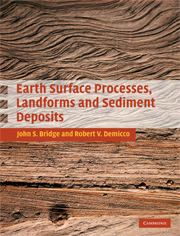Book contents
- Frontmatter
- Contents
- Acknowledgments
- Figure credits
- PART 1 Introduction
- PART 2 Production of sediment at the Earth's surface
- PART 3 Fundamentals of fluid flow, sediment transport, erosion, and deposition
- PART 4 Environments of erosion and deposition
- 13 Rivers, alluvial plains, and fans
- 14 Lakes
- 15 Coasts and shallow seas
- 16 Arid environments
- 17 Glacial and periglacial environments
- 18 Deep seas and oceans
- PART 5 Sediment into rock: diagenesis
- PART 6 Long-term, large-scale processes: mountains and sedimentary basins
- References
- Appendix: Methods of study of Earth surface processes, landforms, and sediments
- Index
- Plate section
13 - Rivers, alluvial plains, and fans
from PART 4 - Environments of erosion and deposition
Published online by Cambridge University Press: 05 June 2012
- Frontmatter
- Contents
- Acknowledgments
- Figure credits
- PART 1 Introduction
- PART 2 Production of sediment at the Earth's surface
- PART 3 Fundamentals of fluid flow, sediment transport, erosion, and deposition
- PART 4 Environments of erosion and deposition
- 13 Rivers, alluvial plains, and fans
- 14 Lakes
- 15 Coasts and shallow seas
- 16 Arid environments
- 17 Glacial and periglacial environments
- 18 Deep seas and oceans
- PART 5 Sediment into rock: diagenesis
- PART 6 Long-term, large-scale processes: mountains and sedimentary basins
- References
- Appendix: Methods of study of Earth surface processes, landforms, and sediments
- Index
- Plate section
Summary
Introduction
Rivers and floodplains have always attracted humans because they provide a supply of water, power, and food. Rivers are used as sewers and for recreation (commonly simultaneously), for transportation, and as political boundaries. Rivers and floodplains are also sources of raw materials such as sand and gravel. These desirable aspects of rivers and floodplains have resulted in all manner of human construction within and adjacent to rivers, including buildings; irrigation canals; dams for water supply, flood control, and recreational lakes; and levees to control flooding. Channels have been straightened and banks stabilized to protect against bank erosion, to accelerate passage of floodwater, and to aid navigation. In addition, sediment in rivers and floodplains has been mined extensively. These human activities have commonly had a detrimental effect on rivers and floodplains, including overuse and pollution of water supply; disruption of freshwater ecosystems; lack of recharging of groundwater in floodplains and associated wetlands; reduction of deposition of fertile silt on floodplains; erosion downstream of dams and sedimentation in reservoirs; and erosion upstream of straightened, leveed channels, with enhanced flooding and deposition downstream. Catastrophic loss of life and damage to property can occur when engineering structures fail. These significant problems require effective management of rivers and floodplains, a degree of restoration of those that have been damaged, and recognition of the inherent fallibility of engineering structures. This in turn requires detailed understanding of their geometry and processes of water flow, sediment transport, erosion, and deposition.
- Type
- Chapter
- Information
- Earth Surface Processes, Landforms and Sediment Deposits , pp. 365 - 461Publisher: Cambridge University PressPrint publication year: 2008
- 2
- Cited by



